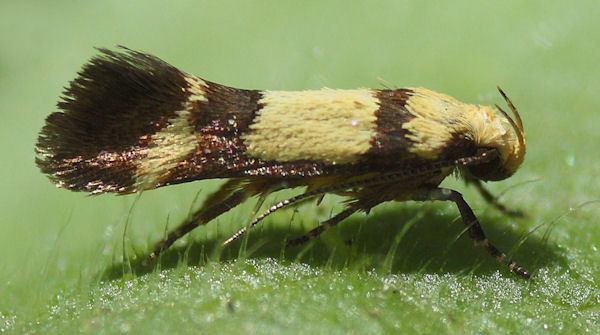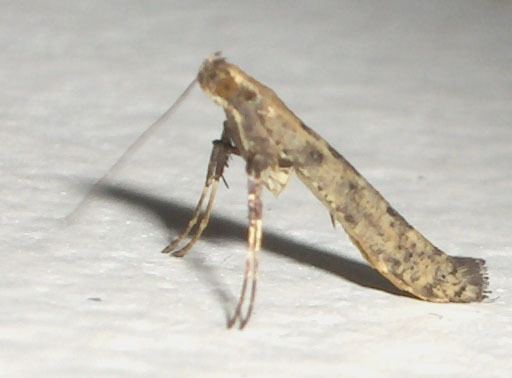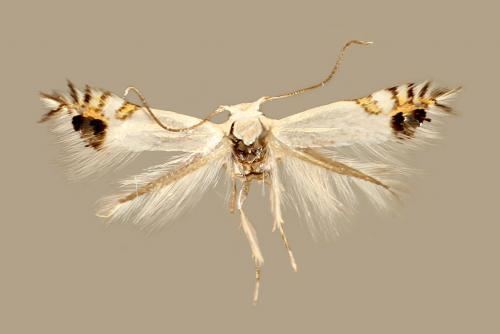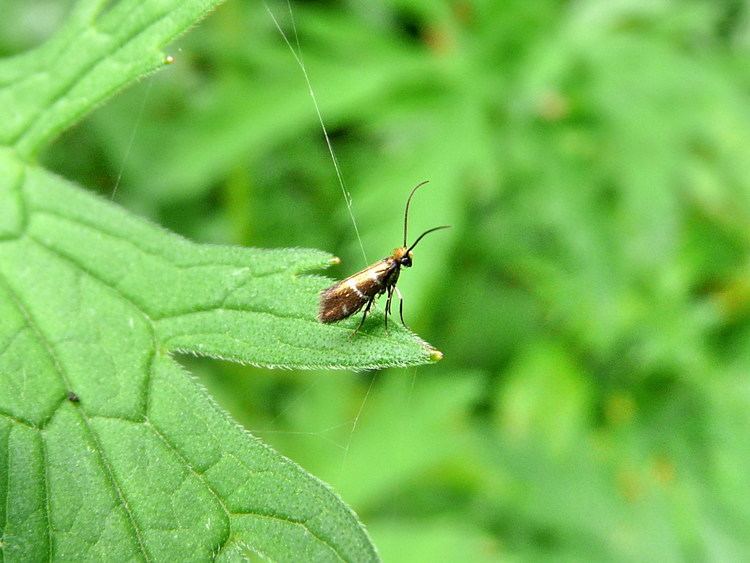 | ||
Representative species | ||
Collecting and pinning microlepidoptera
Microlepidoptera (micromoths) is an artificial (i.e., unranked and not monophyletic) grouping of moth families, commonly known as the 'smaller moths' (micro, Lepidoptera). These generally have wingspans of under 20 mm, and are thus harder to identify by external phenotypic markings than macrolepidoptera. They present some lifestyles which the larger Lepidoptera do not have, but this is not an identifying mark. Some hobbyists further divide this group into separate groups, such as leaf miners or rollers, stem or root borers, and then usually follow the more rigorous scientific taxonomy of lepidopterans. Efforts to stabilize the term have usually proven inadequate.
Contents
- Collecting and pinning microlepidoptera
- Leg waving microlepidoptera
- Diversity
- Life style
- Main groups
- Larger micros
- References

Leg waving microlepidoptera
Diversity

Vernacular usage divides the Lepidoptera simply into smaller and larger or into more-primitive and less-primitive groups: microlepidoptera and macrolepidoptera, respectively. Intuitively, the "micros" are any lepidopteran not currently placed in the macrolepidoptera. This paraphyletic assemblage, however, includes also the superfamilies Zygaenoidea, Sesioidea and Cossoidea that would in common parlance normally be lumped with the "macros". A lepidopterist might call these groups 'primitive macros'. Furthermore, even all of the nonditrysian moths are not small. For example, the Hepialidae or "swift moths" (up to 25 cm wingspan) fall quite basally in the lepidopteran "tree of life". The recently discovered primitive superfamily Andesianoidea is another case in point: lurking within the Cossoidae until 2001, these moths have up to an order of magnitude greater wingspan (5.5 cm) than most previously known monotrysian "micros". Whilst the smaller moths are usually also more seldom noticed, a more expansive "non-macrolepidopteran" concept of the microlepidoptera would include about 37 out of the approximately 47 superfamilies.

Whilst usually less popular, micros are thus more important in the sense that they include a much wider span of the "tree of life" (i.e., phylogenetic diversity). Whereas they include no butterflies, micros do also include a surprising number of day-flying groups, and the advent of online identification resources in many countries (e.g. "UK moths"[1]) combined with the widespread use of digital macrophotography, is making them much easier to identify.
Life style

Microlepidoptera can be found in a broad variety of habitats and ecological niches worldwide, both terrestrial and freshwater aquatic (e.g. Acentropinae). They have a wide variety of feeding habits in both larval and adult life stages. Caterpillars feed on a wide variety of plant tissue and across a wide spectrum of plant groups from liverworts to angiosperms. They are either external feeders ("exophagous") or more usually feed internally ("endophagous"), typically as miners or tunnellers, but some feed on fungi, scavenge on dead animals, are parasitoids usually of other insects (some Zygaenoidea) or are detritivores, and Hyposmocoma molluscivora even feeds on live snails. Adult moths feed with mandibles on spores and pollen (Micropterigidae) on dew (e.g. Eriocraniidae), with their proboscises on nectar (many groups e.g. Choreutidae) or are simply nonfeeding with mouthparts reduced or absent. The larvae of many smaller moths are considered economic pests, causing damage to plants, as well as fabrics and other man-made goods. Commonly noticed "micros" include the plume moth and the various species of clothes moth.
Main groups

The list below is ordered initially in approximate order of species diversity and ecological abundance. The first four superfamilies listed here may comprise 90% of species in a sample of smaller moths and the listed characters may be of some assistance to sort these out, particularly the form of the labial palp and scaling of the proboscis (Robinson et al. 2001).
1. Curved horn moths, twirler moths, case-bearers and allies – 16,250 spp.

2. Pyralids, snout moths and grass moths – 16,000 spp.
3. Tortrix moths, leaf-roller moths, bell moths, codling moths and allies – 6,200 spp.
4. Clothes moths, bagworms and allies – 4,200 spp.
5, 6. Leaf miner moths – 3,200 spp.
7. Ermine moths, webworm moths, yucca moths and allies – 1,500 spp.
8, 9. Plume moths – 1,160 spp.
10. Tropical leaf moths or picture-winged moths – more than 1000 spp.
11. Fairy moths, longhorn moths and allies – 600 spp.
12. Metalmark moths – 402 spp.
13. Mandibulate archaic moths – 180 spp.
14. Sparkling archaic sun moths or spring jewel moths – 24 spp.
Superfamilies less likely to be encountered:
15. Tropical fruitworm moths – 318 spp.
16. Fringe tufted moths – 83 spp.
17. Blackberry leaf skeletonizer and allies – 8 spp.
18. Immid moths – 250 spp.
19. False burnet moths – 60 spp.
20. Tropical teak moths – 20 spp.
21. Whalley's Malagasy moths – 2 spp.
More rarely encountered "primitive" families:
22. Kauri pine moths – 2 spp.
22. Southern beech moths or Valdivian archaic moths – 9 spp.
23. Archaic sun moths – 4 spp.
24. Australian archaic sun moths – 6 spp.
25. Archaic bell moths – 12 spp.
26. New Zealand endemic moths – 7 spp.
27. Gondwanaland moths – 60 spp.
28. Trumpet leaf miner moths – 107 spp.
29. Simaethistid moths – 4 spp.
30. Galacticoid moths or webworm moths – 17 spp.
Larger "micros"
These groups have been formerly included in macros by hobbyists. 'Archaic and primitive macros' is not a recommended name for these as it may create confusion of their placement in some classification systems.
31. Swift moths and allies – 544 spp.
Unassigned to superfamily:
32. Meyrick's mystic moth – 1 sp.
Large monotrysian micros:
33. Andean endemic moths – 3 spp.
Large ditrysian micros (formerly 'primitive macros'):
34. Burnet moths, slug moths, hag moths, glass moths and allies – 2,600 spp.
35. Clearwing moths, castniid moths, little bear moths and allies – 1,300 spp.
36, 37. Goat or carpenter moths and allies – 676 spp.
